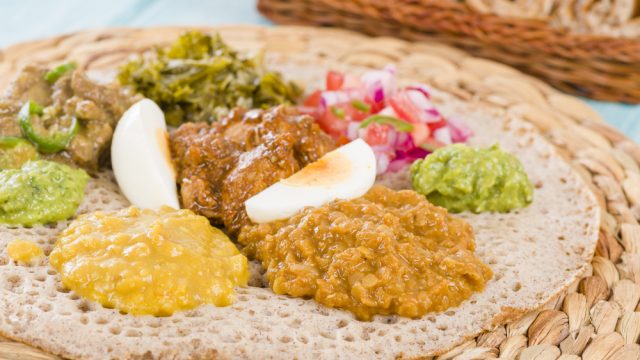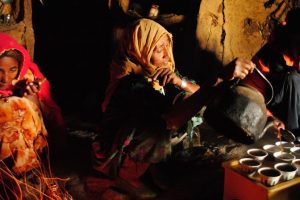Here’s a statement that’s likely to surprise you: Ethiopia has one of the world’s great cuisines. Seriously. It’s varied, spicy, healthy, and utterly unlike anything else you might have eaten before. So, while the Ethiopian capital, Addis Ababa, has an exciting array of restaurants serving flavours from around the world (Italian cuisine is particularly well represented), anyone venturing here and eating only European and Asian food is missing out on one of the most memorable aspects of Ethiopian travel.
What’s Wat?
Ethiopian cuisine essentially revolves around injera and wat. What’s wat and injeras what? Injera, which is made from teff, a cereal endemic to the highlands of Ethiopia, is a large, flat, grey, rubbery pancake-like bread with a slightly sour taste. It might not sound pretty, and frankly it might not look too pretty, but trust us it works. In most restaurants injera is served spread out over a large, tray like dish (although in fancy tourist class restaurants it might come rolled up on a side plate) onto which are splashed rainbow coloured piles of wat. Wat is a catch-all name for a variety of, often fiery hot, meat stews, vegetable curries and even cubes of raw meat. The sour taste of the injera contrasts beautifully with the spice of the wat.
Cutlery isn’t used in Ethiopian restaurants. Instead just tear off a piece of injera, wrap it round a mouthful of wat and pop the lot into your gullet.
Where to Eat
There are gazillions of places to eat traditional Ethiopian fare in Addis. Here are some of our favourites:
Yod Abyssinia Restaurant: Addis has several restaurants that serve up a colourful combination of traditional Ethiopian dishes (often slightly toned down for tourist tastes) with a side portion of traditional music and dance performances. Yod Abyssinia is the best loved such place and although it initially seems to be aimed squarely at tourists it’s actually equally popular with well-to-do locals and is an ideal place for that first tentative taste of Ethiopian delicacies. Bole Medhaniyalem, Tel: 0116-612985
Dashen Traditional Restaurant: Close to the city centre, this place with its stone walls and African art, is a much more authentically traditional restaurant where the food isn’t dumbed down for soft tourist taste buds and, at lunch time especially, loyal locals vastly out number foreigners. It’s worth trying the tibbs (fried slices of meat with garlic and chilli) and fasting food (a mixture of vegetarian dishes traditionally served only on Fridays) here. Occasional live music. Off Itegue Taitu Street, Tel: 0115-529746
Lucy Gazebo & Restaurant: Right next to the superb National Museum, this is a fairly upmarket and very enjoyable restaurant with semi-alfresco dining and a menu that covers all corners of the globe, but it excels when it stays purely Ethiopian. It’s an almost compulsory pit stop for every museum visiting tourist but plenty of locals also drag themselves up here for a long, lazy lunch. King George VI Street
A Caffeine Fix
No discussion about eating out in Addis Ababa can be considered complete without mention of coffee. Ethiopia is in an endless argument with nearby Yemen over which of the two nations is the original home of the bean the world wakes up too. The story goes that the power of coffee was first discovered long ago by a goat herder in western Ethiopia who noticed that after his livestock had eaten the berries from a particular plant they became very active and excitable. The herder himself tried the berries and, impressed by the effect, took some back to his local monastery to show the monks what he had discovered. Describing the berries as the ‘devils fruit’, a monk threw the berries into a fire at which point the aroma of roasting coffee beans made the monk decided the devil wasn’t so bad after-all.
Since then an entire ceremony has arisen over the drinking of coffee in Ethiopia. A traditional coffee ceremony begins with an incense burner loaded with frankincense being lit. Fresh grass is then scattered on the ground in order to ‘introduce the smell and taste of nature’ to the room. The host, who’s normally sat on a low stall before a tiny charcoal stove, roasts the beans in a pan wafting the smoke towards the guests (it’s considered polite to inhale this smoke and express your appreciation of the aroma). Sufficiently roasted the beans are ground down with a pestle and mortar and then brewed. When finally the coffee is ready it’s served in tiny cups with a quantity of sugar that would have most dentists frowning in disapproval. It’s considered polite to drink at least three cups of coffee with the third being the most important as it bestows blessings on the person drinking it. Sometimes popcorn is served alongside the coffee as is chat, a very mildly narcotic leaf that is almost a way of life in eastern Ethiopia (and making serious in-roads elsewhere). Note that though it’s legal in Ethiopia it’s illegal in many other countries.
A traditional coffee ceremony is at its best when performed at home in the company of friends and there are few cafes that offer the experience on a regular basis. However, almost all the more upmarket traditional Ethiopian restaurants perform the coffee ceremony (such as those listed above) as well as many hotels aimed at tourists.
The Italians (who occupied Ethiopia for 6 years during WWII) appreciated the Ethiopian passion for coffee and introduced Italian-style coffee drinking to Addis and today there are numerous cafes serving Italian-style coffee throughout Addis. The most dolce vita of them all though is Tomoca (Wavel Street; Piazza) which, dominated by a huge coffee grinding and roasting machine, attracts dapper old gentlemen in hats and ties. It would be hard to find a resident of Addis who would stand up and claim that Tomoca doesn’t serve the best coffee in the city.


